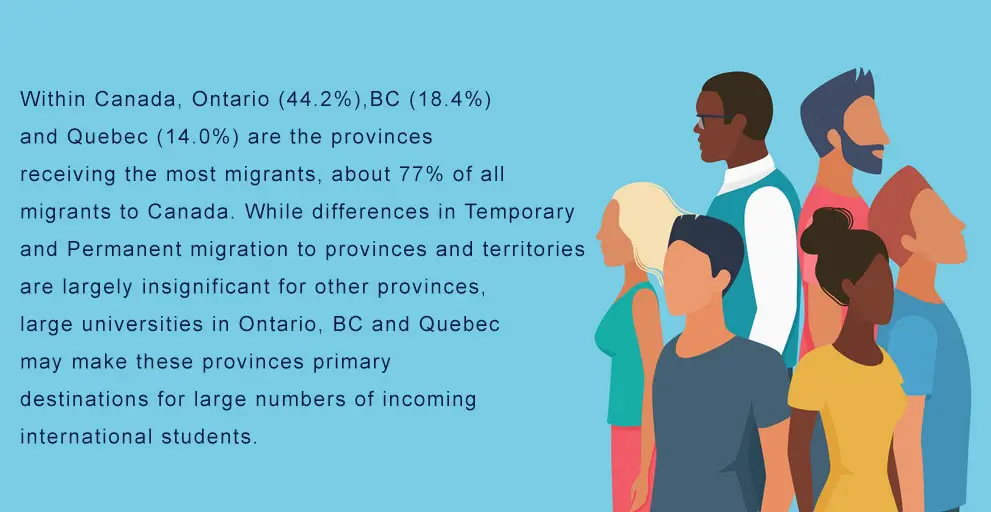Immigration in Canada - Immigration Statistics
Demographic Overview
- Population……………………………………………………………… 37,943,231 (July 2021 est.)
- Population growth rate ………………………………………………………… 0.77% (2021 est.)
- Birth rate……………………………………………. 10.21 births/1,000 population (2021 est.)
- Death rate………………………………………….. 8.08 deaths/1,000 population (2021 est.)
- Net migration rate…………………………… 5.55 migrant(s)/1,000 population (2021 est.)
- Ethnic groups*……………….. Canadian 32.3%, English 18.3%, Scottish 13.9%, French 13.6%, Irish 13.4%, German 9.6%, Chinese 5.1%, Italian 4.6%, North American Indian 4.4%, East Indian 4%, other 51.6% (2016 est.)
* Percentages add up to more than 100% because respondents were able to identify more than one ethnic origin
Canada’s appeal as an immigration destination has been increasing over the past two decades, with a total of 313,580 immigrating to the country in 2019. This figure is a decrease from 2016, when about 323,190 immigrants came to Canada, but is much more than the estimated 199,170 immigrants in 2003.
This statistic shows the total number of immigrants that arrived in Canada from 2000 to 2019, distinguished by gender. In 2019, a total of 160,014 female immigrants arrived in Canada.
While the number of immigrants has been increasing over the years, less than half of surveyed Canadians believed that there were too many immigrants in the country . This is most definitely a positive, since in 2017, the Canadian government announced its aim to significantly increase the number of permanent residents to Canada in order to combat an aging workforce and the decline of working-age adults.

Between July 1, 2017 and June 30, 2018, there were an estimated 132,417 immigrants to Ontario, making it the most popular immigration destination out of any province.
Canada has announced plans to increase the number of immigrants it accepts each year. “To further ease the challenges of a shrinking labor force and an aging population, our new multi-year immigration levels plan sets out the highest levels of permanent residents that Canada will welcome in recent history,” according to Minister of Immigration, Refugees and Citizenship Ahmed Hussen. By 2021,
Canada has long been a country of net immigration and has designed its current immigration policy around attracting highly educated and skilled migrants for entry into its labor force.
Focus on Human Capital
This statistic shows the number of permanent residents admitted to Canada in 2019, by status. In 2019, 68,645 permanent residents were admitted to Canada through the Provincial Nominee Program.
This statistic shows the number of new naturalized citizens in Canada from 2011 to 2019. In 2019, 249,684 people became citizens of Canada.
This statistic shows the total number of immigrants to Canada in 2019, by age. In 2019, 24,450 people aged between 20 and 24 years immigrated to Canada.
Number of Immigrants By Province or Territory (2019)
| wdt_ID | Province or Territory | Immigrants |
|---|---|---|
| 1 | Ontario | 139,071.00 |
| 2 | Quebec | 44,856.00 |
| 3 | British Columbia | 43,151.00 |
| 4 | Alberta | 40,725.00 |
| 5 | Manitoba | 15,918.00 |
| 6 | Saskatchewan | 13,910.00 |
| 7 | Nova Scotia | 6,393.00 |
| 8 | New Brunswick | 5,076.00 |
| 9 | Prince Edward Island | 2,267.00 |
| 10 | Newfoundland and Labrador | 1,651.00 |
| 11 | Yukon | 310.00 |
| 12 | Northwest Territories | 227.00 |
| 13 | Nunavut | 25.00 |
| Province or Territory | Immigrants |
Ontario was the province with the most immigrants in 2019, with 139,071 immigrants living within its boundaries. Nunavut, Canada’s northernmost territory, had 25 immigrants residing there in the same year.

Over the past 20 years, the number of immigrants to Canada has held steady and is just about evenly split between men and women. Asian countries dominate the list of leading countries of birth for foreign-born residents of Canada, although the United Kingdom, the United States, and Italy all make the list as well.
Immigration to Canada
Profiles of immigrants to Canada
The gender of immigrants to Canada in 2018 was just about an even split, with 150,405 male immigrants and 152,852 female immigrants. In addition, most foreign-born individuals in Canada came from India, followed by China and the Philippines. The United States was the fifth most common origin country for foreign-born residents in Canada.

The big Canadian immigration news in 2019 was the number of Indians who became permanent residents in Canada increased from 39,340 in 2016 to 85,585 in 2019, a rise of more than 117%, according to a National Foundation for American Policy (NFAP) analysis of Immigration, Refugees and Citizenship Canada data.
This statistic shows the number of permanent resident immigrants in Canada from 2000 to 2019. In 2019, there were an estimated 341,190 immigrants who were permanent residents in Canada.
This statistic shows the number of permanent resident immigrants admitted in Canada in 2019, by entry category. 48,510 of the permanent resident immigrants admitted in Canada in 2019 were resettled refugee and protected persons.

This statistic shows the number of foreign-born people residing in Canada in 2016. There were 668,565 people born in India living in Canada in 2016.
This statistic shows the number of international students in Canada from 2000 to 2017 at year’s end. In 2017, there were 492,533 international students in Canada at year’s end.

Globally, Canada’s international student programs are the largest driver for temporary migration to Canada accounting for 400,995 temporary residents in 2019. Further, the increase in temporary migrants to Canada is almost exclusively due to substantially rising numbers of international students coming from low and middle-income countries. India provides the most striking example, with a more than eighty-fold increase in international students between 2000 and 2019.
Education
This statistic shows the top ten origin countries of international students at year’s end in Canada in 2017. 165,900 international students at year’s end in Canada came from China in 2017.

This statistic shows the number of international students in Canada in the academic year of 2017 to 2018, by postsecondary program enrollment category. In that year, there were 3,219 international students in Canada enrolled in postsecondary education programs.
This statistic shows the number of immigrants in Canada with permanent resident status in 2019, be level of education. In 2019, about 1.4 million permanent resident immigrants in Canada had only a high school diploma.
Level of education

Labor
This statistic shows the number of International Mobility Programs work permit holders in Canada from 2000 to 2017. In 2017, there were 321,743 IMP permit holders in Canada. This is an increase from 2000, when there were 44,118 IMP permit holders.
This statistic shows the number of Temporary Foreign Worker Program work permit holder in Canada from 2000 to 2017. In 2000, there were 22,752 TFWP permit holders in Canada.
Originally designed for skilled labor shortages primarily in the Alberta oil patch, in 2002 the government expanded the temporary worker program to include hospitality, food, construction, and manufacturing.
Temporary Worker Program
This statistic shows the rate of unemployment among landed immigrants in Canada in 2019, by level of education. In 2019, 6.9 percent of immigrants in Canada with a high school diploma only were unemployed.
Unemployment among immigrants
In 2018, the unemployment rate for immigrants in Canada was highest among those who had been in the country for five years or less. The unemployment rate decreased the longer someone had been in Canada, and unemployment was lowest among those who had been in the country for more than ten years, coming more into line with the average unemployment rate for the whole of Canada .
This statistic shows the average earned income of immigrants in Canada in 2016, by admission category. In 2016, people who immigrated as the principal applicant under the skilled worker category earned, on average, 38,600 Canadian dollars.
Immigrants in the Workforce
Source:
- http://www.cic.gc.ca/opendata-donneesouvertes/data/IRCC_M_PRadmiss_0002_E.xls
- https://open.canada.ca/data/en/dataset/f7e5498e-0ad8-4417-85c9-9b8aff9b9eda
- https://open.canada.ca/data/en/dataset/2bf9f856-20fe-4644-bf74-c8e45b3d94bd
- http://www5.statcan.gc.ca/cansim/a26?lang=eng&retrLang=eng&id=2820108&tabMode=dataTable&srchLan=-1&p1=-1&p2=9
- https://www150.statcan.gc.ca/t1/tbl1/en/cv.action?pid=4310001101
- https://www150.statcan.gc.ca/t1/tbl1/en/tv.action?pid=3710001801
- https://www150.statcan.gc.ca/t1/tbl1/en/tv.action?pid=1410008701
- https://www.migrationpolicy.org/article/canadas-immigration-policy-focus-human-capital
- https://www.forbes.com/sites/stuartanderson/2020/02/18/immigrants-flock-to-canada-while-us-declines/
- https://www.apnatoronto.com/citizenship-test/
- https://cidpnsi.ca/migration-flows/
- https://www.cfr.org/backgrounder/what-canadas-immigration-policy
